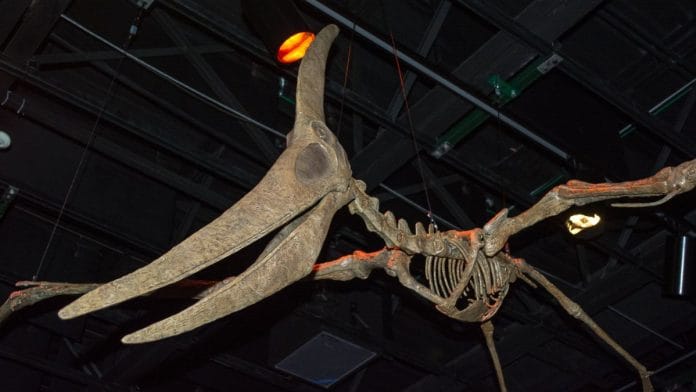New Delhi: A fossil of a 70 million-year-old Pterosaur, the first flying vertebrate in the world, was found with a bite mark on its neck bone, from what scientists say could be a crocodile-sized animal.
A paper published Thursday in the Journal of Paleontology said that the pterosaur fossil, discovered in Alberta, Canada has a four-millimetre-wide bite mark on its neck, which is quite rare because pterosaur bones are very delicate.
The bite mark from a crocodilian is indicative of what kind of animals interacted with each other in the Cretaceous period, and it is especially interesting because crocodilians and pterosaurs are both close relatives and considered to be the ancestors of modern-day birds.
There is more to be unearthed about how the bite mark got onto the fossil, and whether it occurred when the pterosaur was alive or dead, but scientists do say that it will not be surprising if pterosaurs were part of a crocodilian diet in the Cretaceous age, 70 million years ago.
1000+ citizen scientists help exercise to study pollination activity
A novel study on pollination is a rare win for citizen science, with over 1,000 people from 32 European countries participating in an experiment to collect data on cowslip plants. These common flowering plants are found across Europe, and have two unique flowers that allow for both self-pollination and pollination by insects.
However, scientists from the University of Tartu, Estonia, in a study published Wednesday in the Journal of Ecology, found that because of warmer climates and land-use change, the insect-pollinated flowers are decreasing, and self-pollinated flowers have a nine percent higher presence.
To make this discovery, the scientists enlisted the help of European citizens through a website, asking them to observe cowslips around them, take pictures and upload them on a single portal with their coordinates. Over four years, from 2019 to 2022, around 9,00,000 cowslips across Europe were observed.
2024 PT5, Earth’s mini-Moon last year, discovered to be part of real Moon
In September 2024, a report in Scientifix mentioned how Earth would have a mini-moon for two months. An asteroid called 2024 PT5 was pulled in by the Earth’s gravitational pull and orbited the planet, almost like a moon, between September and November last year.
Now, a group of scientists from NASA’s Jet Propulsion Laboratory have found that this asteroid might actually be a piece of rock ejected from our original Moon, thousands of years ago.
The study describing the findings was published on 14 January in The Astrophysical Journal Letters.
Scientists were curious about it because the orbit it followed is not commonly associated with asteroids from the main asteroid belt of our solar system. They then obtained images of PT5 using NASA’s infrared telescope facility and found that its properties didn’t match any previous asteroid samples, but instead matched our existing lunar samples.
It was rich in silicate minerals, exactly like the Moon’s surface. NASA scientists are calling this a rare kind of study, where research on asteroids is leading them towards uncovering the history of the Moon.
Perils of ozone exposure
Ground-level ozone exposure has long been known to cause health issues in humans, but a new study published on 22 January shows exactly how it causes hypoxia and arterial stiffness because of the deficiency of oxygen to the body.
The study was conducted on the Qinghai-Tibet Plateau in China, on residents who were exposed to high concentrations of ozone. The gas, which helps humans as a layer in the atmosphere, becomes deadly on the ground. The scientists found that even mild, short-term exposure to ozone for one to seven days led to oxygen saturation in the body, and an increase in red blood cell count.
This paper is especially pertinent, when we look at the fact that ground ozone levels in India, particularly in New Delhi, are very high. For 176 days in the summer of 2024, Delhi’s ground ozone levels were higher than the recommended safety standards.
(Edited by Radifah Kabir)






